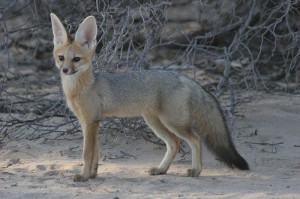The Cape Fox
Bongsong · 9 months ago
Also known as the Silver Fox or the Silver Jackal, the Cape Fox is mainly found in the southern part of Africa. Quite a small fox, with a weight of between 3-5kgs, the Cape Fox usually has silver coloured fur on it’s back (hence it’s other name) blending into a yellowy underbelly, big ears and a black tip on the end of it’s tail. The areas the Cape Fox likes to inhabit are grasslands, arid terrain, scrubland and savanahs. The foxes like to burrow and create their own underground tunnel network, though they are also commonly known to take over the dens of other burrowing animals, provided they have been abandoned first. Litter size can range from anywhere between 1-6 cubs and the cubs are brought up in these underground lairs until they are old enough to hunt for themselves, which usually occurs at around 5 months. The young Cape Foxes can mate as early as 9 months (a little earlier than the Red Fox) and can expect to live between 6-10 years Living in the plains of southern Africa, the Cape Fox does have a wide variety of predators to watch out for, including eagles, hyenas and lions as well as being susceptible to rabies. Humans are also a threat in terms of hunting, poisoning and being hit by cars. Currently, however, the Cape Fox is not losing it’s habitat and the Cape Fox population is considered to be quite healthy. Indeed, some southern African farmers like the Cape Fox because of their propensity for catching rodents. But they are considered to be omnivores, eating both meat and plant life and are quite likely to eat anything they can in true opportunist style. Unfortunately, Cape Foxes (or Vulpes Chama) are often involved in cases of mistaken identity with jackals (explaining their alias of ‘Silver Jackals’) and are often killed by farmers who are intending to stop jackals attacking their livestock. There is also a debate amongst farmers as to whether the Cape Fox actively hunts and kills farmstock, or whether they simply feats on carcasses that have been caught and left by other animals. This argument about the Cape Fox seems to be ongoing and unresolved. The specific countries where the Cape Fox inhabits are Namibia, South Africa, Botswana Zimbabwe and Lesotho. Because the Cape Fox is so adaptable and not fussy in it’s diet, it is able to thrive in many different areas of these southern African countries.
